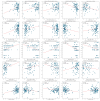Salivary Biosensing Opportunities for Predicting Cognitive and Physical Human Performance
- PMID: 40710068
- PMCID: PMC12292893
- DOI: 10.3390/bios15070418
Salivary Biosensing Opportunities for Predicting Cognitive and Physical Human Performance
Abstract
Advancements in biosensing technologies have introduced opportunities for non-invasive, real-time monitoring of salivary biomarkers, enabling progress in fields ranging from personalized medicine to public health. Identifying and prioritizing the most critical analytes to measure in saliva is essential for estimating physiological status and forecasting performance in applied contexts. This study examined the value of 12 salivary analytes, including hormones, metabolites, and enzymes, for predicting cognitive and physical performance outcomes in military personnel (N = 115) engaged in stressful laboratory and field tasks. We calculated a series of features to quantify time-series analyte data and applied multiple regression techniques, including Elastic Net, Partial Least Squares, and Random Forest regression, to evaluate their predictive utility for five outcomes of interest: the ability to move, shoot, communicate, navigate, and sustain performance under stress. Predictive performance was poor across all models, with R-squared values near zero and limited evidence that salivary analytes provided stable or meaningful performance predictions. While certain features (e.g., post-peak slopes and variance metrics) appeared more frequently than others, no individual analyte emerged as a reliable predictor. These results suggest that salivary biomarkers alone are unlikely to provide robust insights into cognitive and physical performance outcomes. Future research may benefit from combining salivary and other biosensor data with contextual variables to improve predictive accuracy in real-world settings.
Keywords: biosensor; cognitive performance; cortisol; enzymes; hormones; metabolites; physical performance; stress.
Conflict of interest statement
The authors declare no conflicts of interest. Author T.T.B. was employed by the funding agency during all aspects of the study.
Figures



Similar articles
-
Comparison of Two Modern Survival Prediction Tools, SORG-MLA and METSSS, in Patients With Symptomatic Long-bone Metastases Who Underwent Local Treatment With Surgery Followed by Radiotherapy and With Radiotherapy Alone.Clin Orthop Relat Res. 2024 Dec 1;482(12):2193-2208. doi: 10.1097/CORR.0000000000003185. Epub 2024 Jul 23. Clin Orthop Relat Res. 2024. PMID: 39051924
-
Falls prevention interventions for community-dwelling older adults: systematic review and meta-analysis of benefits, harms, and patient values and preferences.Syst Rev. 2024 Nov 26;13(1):289. doi: 10.1186/s13643-024-02681-3. Syst Rev. 2024. PMID: 39593159 Free PMC article.
-
Sexual Harassment and Prevention Training.2024 Mar 29. In: StatPearls [Internet]. Treasure Island (FL): StatPearls Publishing; 2025 Jan–. 2024 Mar 29. In: StatPearls [Internet]. Treasure Island (FL): StatPearls Publishing; 2025 Jan–. PMID: 36508513 Free Books & Documents.
-
Are Current Survival Prediction Tools Useful When Treating Subsequent Skeletal-related Events From Bone Metastases?Clin Orthop Relat Res. 2024 Sep 1;482(9):1710-1721. doi: 10.1097/CORR.0000000000003030. Epub 2024 Mar 22. Clin Orthop Relat Res. 2024. PMID: 38517402
-
The Black Book of Psychotropic Dosing and Monitoring.Psychopharmacol Bull. 2024 Jul 8;54(3):8-59. Psychopharmacol Bull. 2024. PMID: 38993656 Free PMC article. Review.
References
MeSH terms
Substances
Grants and funding
LinkOut - more resources
Full Text Sources

